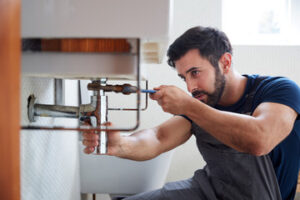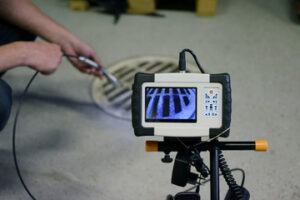Hot water is one of the most important conveniences in the modern home. We use it for showers, washing clothes and dishes, and cooking. Most homes use a traditional storage tank water heater powered by electricity, natural gas or fuel oil. They’re usually tucked away in a basement or utility room.

Water Heater Denver is a one of the most crucial appliances in your home, yet they’re often overlooked until they break down or stop working. Until that happens, it’s difficult to appreciate just how much we depend on them for hot showers, clean laundry, and dishes. This essential appliance may look like a big metal cylinder in your basement, but its simple design hides an ingenious construction on the inside that exploits the principle that heat rises to deliver hot water on demand.
The first layer is the tank itself, which is typically made of steel and can hold 40-60 gallons of water. It’s coated with a protective glass liner and has an outer layer that serves as an insulator. It has 3 pipes for water transfer: one to bring cold water in, another to move hot water out, and a safety valve that prevents overpressure or temperature extremes.
Next is the heating mechanism, which is usually a gas valve or an electric element. The dip tube feeds cold water into the tank, and the heating mechanism stays on until it reaches your desired set point (usually around 140 degrees Fahrenheit). Finally, the thermostat controls how hot you want your hot water to be.
Solar water heaters are another option, but they require a warm and sunny climate to work. They also take a while to refill after they run dry, and they can’t produce enough hot water for all your household needs at once. That’s why most solar water heaters come with a backup gas or electrical heating method.
A more energy-efficient alternative to traditional water heaters is a tankless unit. This compact wall-mounted heater has no storage tank, so it doesn’t consume any standby energy. It’s more expensive than a traditional tank, but it saves money in the long run thanks to lower energy bills. It’s also easier to install, as it can be positioned near your source of hot water rather than in the basement or garage. You can even get a whole-house model, which provides hot water for your entire house.
Types
Water heaters are vital to many of the daily tasks we perform, from showering and bathing to washing clothes and dishes. They work hard to keep us comfortable and help make our home run smoothly. But they come in different varieties with their own strengths and weaknesses. When selecting a new one for your home, it is important to know the differences between the types of water heaters. Knowing the names, functions, and pros and cons of each can help you decide what is best for your household.
The most common type of water heater is the storage tank type. These have an insulated tank that holds the water and is heated by a heating element. A pipe emerges from the top of the heater to supply hot water when needed. These types of water heaters are available in electric and gas models. Generally, the gas model is more efficient than the electric version and costs less to operate.
Solar water heaters are a popular alternative to conventional storage water heaters, and they offer the same benefits as gas or electric models, but are more eco-friendly and energy efficient. They work with solar panels to heat the water and use natural sunlight as their primary source of energy, so they can save you money on your electricity bills in addition to being a great way to reduce your carbon footprint.
These are also known as tankless or on demand water heaters, and they have a much smaller design that takes up less space. They use a heat pump system to move the heat from the air or ground to the water tank, so they are more energy efficient than traditional models. However, they will require a larger upfront investment and may have higher utility costs than other types of water heaters. For this reason, they are not suitable for every household. They are usually used in homes with piped natural gas and in cold climates. The heat pumps on these models are very durable, so they can last for years. However, if they are not properly maintained and replaced on a regular basis, they can wear out faster than other types of water heaters.
Installation
Water heaters require proper installation to ensure the safety and efficient operation of the unit. If you are unsure of your ability to complete the work on your own, consider hiring a professional to do it for you. It is important to follow local and manufacturer guidelines for safe installation, including the use of dielectric fittings to limit corrosion between different metals that come into contact with each other. Local codes may also require seismic straps for the water heater to prevent it from falling or becoming displaced in the event of an earthquake.
To prepare for the water heater installation, start by turning off the power to it. You can usually do this at the circuit breaker box, but you might need to check with your home’s electrical system provider for specific instructions. Next, drain the tank by attaching a hose to the drain valve and directing it to a floor drain or outside destination. After the water is drained, remove any access plates and disconnect the hot and cold water lines using a pipe wrench or channel-lock pliers for compression or union fittings, and a tubing cutter for straight line connections.
Once the water heater has been removed, install the new one in a suitable location on your property. It should be free from any obstructions and provide sufficient space for operation and maintenance. It is essential that you read the installation manual and local code requirements carefully to make sure that you follow all safety and efficiency guidelines.
If your new water heater will be gas-powered, you must connect it to the gas supply lines following the manufacturer’s instructions. You may need to install a sediment trap on the gas line into the unit to reduce the amount of dirt, sediment and debris that can damage or contaminate your water supply. Local codes might also require a ventilation system for gas-powered water heaters to prevent carbon monoxide from building up in the house and causing serious health problems.
Finally, connect the electrical wires to the designated terminals on the new water heater according to the manufacturer’s instructions. Once the connection is made, you can turn on the power and water supply to test the system.
Maintenance
As with any home appliance, prevention is the best medicine when it comes to extending the life of a water heater. Regular inspections by an experienced professional can spot problems before they become major issues that may require a replacement. It is also recommended to flush and drain the tank on a regular basis. These actions help remove sediment and debris that could interfere with the heating process, leading to increased energy usage and higher energy bills.
If you notice that your water is taking longer than normal to heat, or if the temperature seems lower than usual, it may be time for a thermostat adjustment. This can be done easily, and is one of the most important maintenance activities that you can perform on a water heater.
To access the thermostat, start by turning off the electricity or gas supply to the unit. Next, find the access panel and remove it carefully. Depending on the size of your water heater, this might be two separate panels. Once you have access, locate the thermostat dial or control knob and adjust to a setting that fits your household needs, typically 120 degrees Fahrenheit.
When completing a maintenance task on your water heater, always remember that it contains flammable and dangerous materials. It is also important to keep children and pets away from the water heater. If you are unsure of how to proceed with a particular water heater maintenance task, it is a good idea to contact a licensed and experienced plumber or HVAC technician.
A water heater is an essential piece of equipment that can provide a household with hot water and comfort. It is expected to last for 10-12 years with proper maintenance and care. Follow the tips above to extend the life of your water heater. If you have any questions about the operation or maintenance of a water heater, please feel free to contact us today! Our knowledgeable staff can answer any questions you may have. We look forward to hearing from you!


